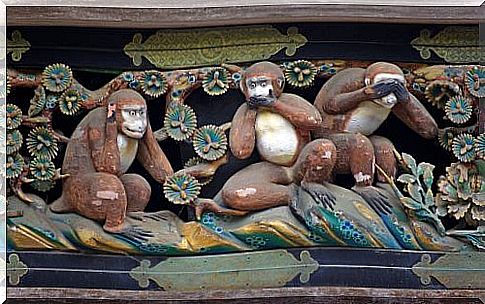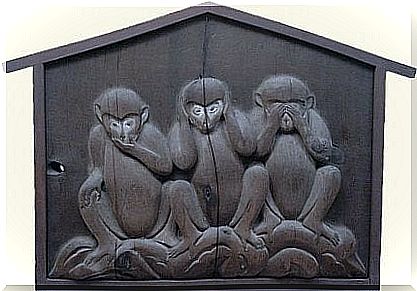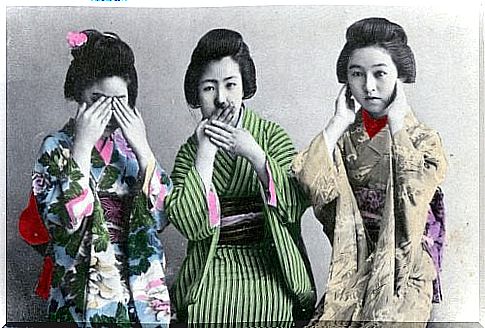The Fascinating Message Of The Three Wise Monkeys

The classic story of the three wise monkeys at Toshogu Shrine teaches us a very simple yet timeless lesson: we must be careful about what we say, what we hear, and what we see.
This famous Shinto shrine is located in Japan. The sculpture of the monkeys – one monkey covering its mouth, another its eyes and a third its ears – dates back to 1636. Few statues have become as scattered around the world and preserved as long as the statue of the three wise men monkeys.
These three monkeys are an icon.
However, the meaning behind this sculpture is gradually being lost.
For the Japanese, for example, this image refers to a philosophical code of conduct for attentive behavior:
This is a lesson derived from the writings of Confucius. However, many people get a feeling of ‘surrender’.
Philosophers
Some historians, on the other hand, see a resemblance between the image of the three wise monkeys and the three filters of Socrates. In this sense, this well-known image can be much better applied to our modern day-to-day lives. The three wise monkeys have nothing to do with an ancient Eastern servility imposed by making injustice invisible or audible.
We invite you to reflect on these wise lessons.
Socrates’ three filters
To understand the similarity between the three wise monkeys and Socrates’ three filters, it is helpful to understand the story of the three filters and the lesson behind them:
A student came to inform Socrates that someone had criticized him.
Before the nervous student could even open his mouth, Socrates asked him these three questions. These were the filters the student had to think about before continuing to tell Socrates.
These three filters were:
- The filter of truth: Is what you intend to tell me really true? Have you checked everything you want to tell me with dexterity, care and restraint to make sure it’s all right?
- The filter of goodness: Is what you want to tell me good or kind?
- The filter of necessity: Is what you want to tell me necessary? Is it helpful or necessary to tell me?
The purpose of these filters
The purpose of these three filters is to guide us to be wiser, more careful, and more critical with everything we say.
Many people see a connection between this lesson and the lesson of the three wise monkeys in Japan.
The lesson of the three wise monkeys
Let’s take a closer look at this familiar image.

The Monkey Covering His Mouth: Iwazaru
Iwazaru is the little monkey you see on the left. According to Japanese philosophy, this monkey represents the need not to spread evil. This image is even associated with the advice not to express your own dissatisfaction or negative feelings.
Being sensible also means doing your best not to expose your own emotional world too much. It’s about staying calm and not letting yourself know too much.
To gossip
The connection between the lesson this monkey represents and the three filters of Socrates is in the resemblance to the need not to gossip too much. Gossip is not always true. Often they are not good at all and it is not always necessary to say them out loud.
The monkey that covers his ears: Kikazaru

Kikazaru is the monkey in the middle.
In Japan, people who spread gossip, criticism or bad news are very much looked down upon. That’s why the Japanese also think it’s better to keep your ears covered for this kind of information, to keep their own balance.
This traditional idea might be quite shocking in the western world. In the West, bad news, gossip and criticism are constantly spread from one place to another.
Different meanings
However, by applying Socrates’ filters to it, we can highlight different meanings. Sometimes we just have to take in negative information because it is useful information. For example, when you have to tell your boss that her customers are not completely satisfied and she should do something to keep them.
However, if the information is not useful at all and at the same time harmful, then it is wise to follow the wise lesson of the monkey Kikazaru and cover your mouth.
The monkey that covers his eyes: Mizaru

According to the santai philosophical and moral code, it is better not to see or hear injustice, nor to speak about it. As most of us know, this idea doesn’t really hold true in real life.
However, by looking at the image of the third monkey through Socrates’ three filters, we may realize something: it is a direct invitation to close our eyes to the things that are neither useful nor good.
Close your eyes to darkness to focus on the lighter, more hopeful, and more meaningful side.
What we can learn from these three monkeys
All in all, these three monkeys teach us a little more about our own needs and that we should always be sensible and careful, especially when it comes to harmful or negative thoughts.
‘Watch your language. Cover your ears so that you don’t hear anything that isn’t helpful or helpful, and close your eyes to the things that are harmful and make you unhappy.’









